18 August 2023
![]() 8 mins Read
8 mins Read
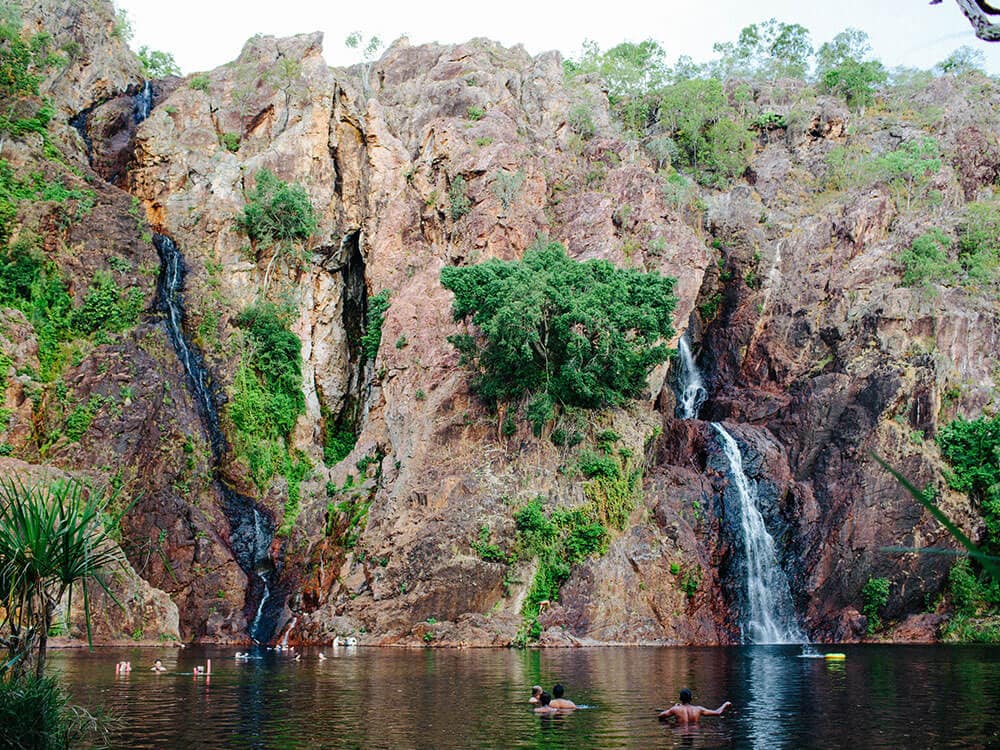
In a territory literally swathed in wild landscapes brimming with some of the world’s most striking wildlife, the fact Litchfield is at the top of tourists’ must-visit lists says a lot. Simply put, the park has the NT trifecta: it’s easy to reach, offers affordable accommodation, and its attractions are worthy of repeat visits. Located 115 kilometres’ south of Darwin, it’s easy enough to rise in the city early, tick off the main waterfalls and be back in your harbourfront hotel by sunset as it’s only an hour and 20 minutes by car. But our advice is to slow it right down: Litchfield deserves more and so do you.
My biggest tip for a truly awesome Litchfield experience is to stay in the park and get out of bed not long after the sun comes up every morning. The waterfalls can become crowded by noon, so opt for a light breakfast and fast-track to your designated natural plunge pool so you have it all to yourself for a little while.
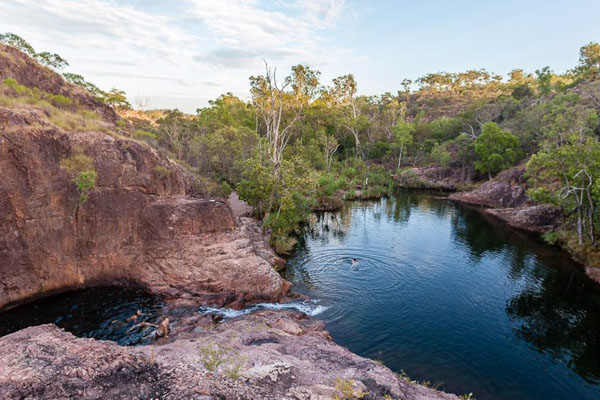
The beautiful Litchfield National Park (photo: Sarah Mackie).
The best way to “do” Litchfield is with a 4WD and tent, camper trailer or caravan – or, if you need to hire a vehicle, a campervan. There’s a Britz/Maui branch in Darwin; be sure to check its seasonal opening hours. One of the best things about Litchfield is that it’s accessible to 2WDs, however, the sturdier your vehicle the more (unsealed) roads you’ll be able to venture down. For more on road-tripping in the NT, check out AT’s guide.

Many of the Northern Territory’s most stunning sites, and a few of its more direct routes, are 4WD access only.
If none of those options work, you can join a tour: AAT Kings offers short-break Kakadu and Litchfield itineraries, and NT Air runs helicopter tours of numerous park attractions if you feel like splurging. If you opt for a self-guided tour, the closest service station and convenience store to Litchfield is at Batchelor.

Get set for real adventure and connect with nature at Litchfield National Park. At just over an hour from Darwin, it’s every local’s favourite day trip.
When planning your trip, you need to give serious thought as to what type of experience you want, as Top End weather will play a big role in which campgrounds, attractions and roads are open. The peak tourist season is winter or “the dry” (May to October) because this is when you can roam fairly freely and swim in the waterholes without fear of spying a pair of croc eyes within arm’s reach. However, campgrounds can book out, so it’s best to plan ahead. In the tropical summer (November to April), some roads and walking tracks close, but most of the park is open year-round and there are viewing platforms from which you can watch the falls.
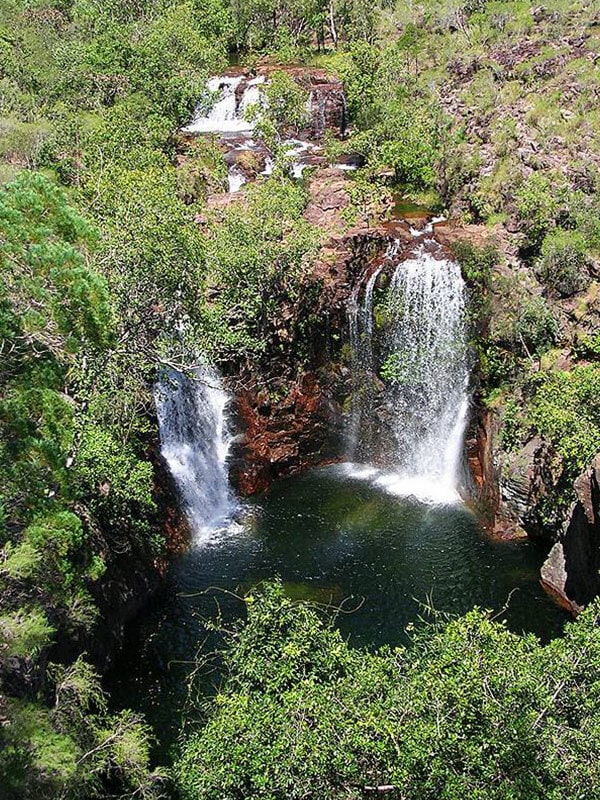
Litchfield has incredible waterfalls during the wet season.
Litchfield National Park is famous for its thunderous waterfalls and natural swimming holes and there are a handful of truly spectacular ones you really don’t want to miss on your visit.
The twin cascades of Florence Falls make it undoubtedly Litchfield’s star attraction. Families splash about in a rockery, big kids scale rock walls so they can backflip into the abyss, and everyone else bobs about in the cool, dark drink, in inflatable rings, occasionally being lured to the waterfalls for a shoulder pummelling.
The spring-fed falls are easy to reach and if you have a couple of days at Florence you should greet them from both angles: walk alongside the creek from Florence Falls Campground (4WD-only) and down the (160) stairs from the main car park above the falls. From the car park, there’s also a path that leads to a small lookout which commands great views that you will have to jostle alongside busloads of tourists to enjoy.

Litchfield’s star attraction, Florence Falls.
The other big name in Litchfield is Wangi. The pool at the base of the double waterfall is much bigger than Florence and there’s also a large, timber platform to spread out on. A boardwalk skirts part of the water’s edge, while a trail leads away into monsoon rainforest. If you’re craving some holiday exercise, follow the path up the mountain and over the top of the waterfall before descending back to the cool pool below. You’ll want to be reasonably agile and fit to enjoy the walk, although it is suitable for tenacious toddlers.
I also love the grassy picnic area at the entry to the falls, which is a top spot for chilling out; expect free wi-fi. If you don’t feel like packing your own lunch, check out Wangi Falls Cafe near the car park.
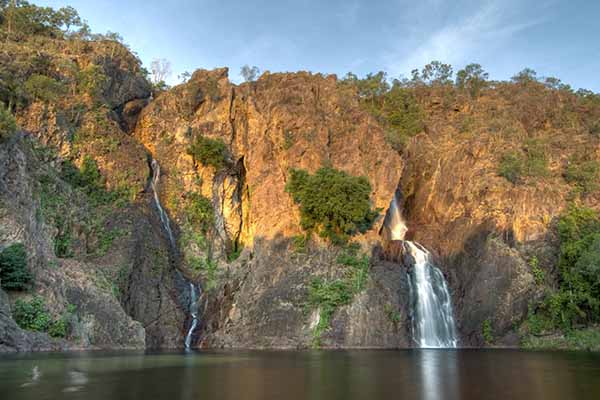
Breathtaking Wangi Falls at sunset.
One of the most accessible swimming spots is Buley Rockhole, which is also the best for young families due to the fact it comprises a series of pools. The top pools are fairly shallow and safe for toddlers, while teens will love the lower, deeper holes. The fresh water is crystal clear and makes for a deliciously revitalising start to the day.
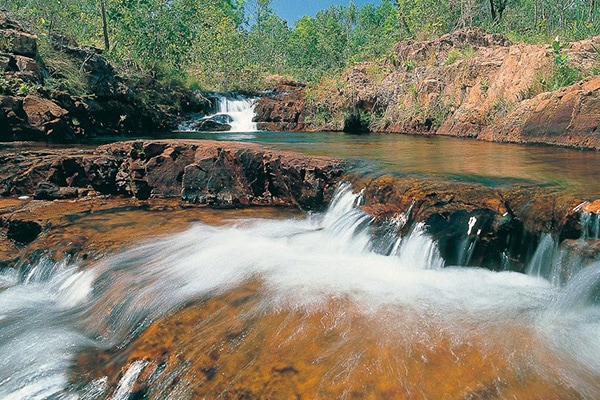
Buley Rock Pools in Litchfield National Park.
If you’re staying a few days and are keen to venture beyond the three most popular waterholes, there are a few others you can check out. Tolmer Falls is considered by some visitors as the most spectacular in the park due to its 100-metre drop, and can be reached via a sealed road and the 1.6 kilometre (45-minute) Tolmer Falls loop walk. You can’t swim here but you can soak in the views from two platforms.
There is also Tjaynera Falls (Sandy Creek Falls) and Surprise Creek Falls, both of which can only be reached by 4WD. Tjaynera is a little different to the rest in that the 3.4-kilometre (return) trail in is surrounded by paperbarks and fairly dry in comparison to the monsoon forest of the other areas. It’s also a quieter option if you’re after somewhere secluded, as is Surprise Creek Falls. To reach the latter, you’ll have to tackle river crossings.
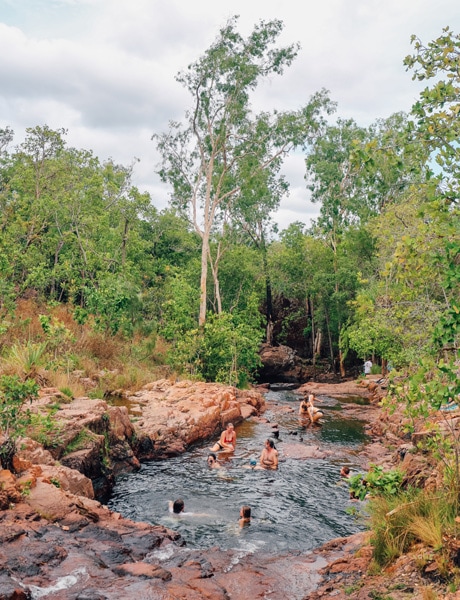
Float inside a network of peaceful waterholes at Buley Rockhole.
Waterfalls aren’t the only reason to visit, there are many more unique experiences to be had in Litchfield National Park, from termite mounds to a lost city and a butterfly farm.
As you enter Litchfield, you’ll notice a field of termite mounds. Some rise as high as two metres and there are hundreds of them, making a pretty quirky photo op. The termites have cleverly built their knife-like homes so the broad backs of the mounds face east and west, and the temperature inside remains stable in the NT’s heat. There are also cathedral termite mounds that rise up to four metres; they’re best viewed from the boardwalk.
If strange formations fascinate you, also make time for The Lost City, a series of large sandstone towers eroded by the elements. With maze-like patterns, the pillars get their name for their resemblance to a long-forgotten city. It’s the perfect place to let your imagination run wild, and creative kids will love it. Note: you will need to be adept behind the wheel to reach this captivating place as the single-lane 4WD track is rough and often impassable in the wet season.
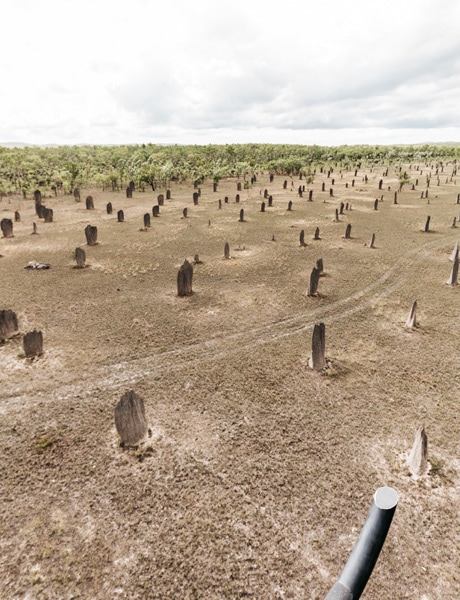
Make sure to stop off at the Magnetic Termite Mounds.
Finally, you can add a little history lesson to your park stay by dropping into historic Blyth Homestead, the former residence built by a family of pioneers in the 1920s. Abandoned in the 1960s, the property was also the site of a tin mine. Again, you’ll need a 4WD to reach the homestead, which is inaccessible during summer; entry is free.
If you’re teaching your kids about metamorphosis or simply want to experience an off-beat tourism attraction (something the Territory is famous for), call into Batchelor Butterfly Farm and Petting Zoo at the end of your Litchfield stay. Journalist Jennifer Pinkerton describes the enclosure as “slightly weird, but absolutely beautiful” and you can learn about Australian species on daily tours. The farm is a 30-minute drive from Litchfield National Park.
The small and tidy Old 4WD Florence Falls Campground (now 2WD accessible) offers the best base for campers. Sites are suitable for vans, campers and tents, and there’s a clean and modern shower and toilet block, too. There is another 2WD campground up the road.
If you’re a long-term traveller keen to hang around, check out nt.gov.au for any openings for volunteer campground hosts. These positions can be taken up to a year in advance but, if you’re organised and snag one, you can stay in one of the best national parks in Australia for free, in exchange for keeping it spic and span.
LEAVE YOUR COMMENT